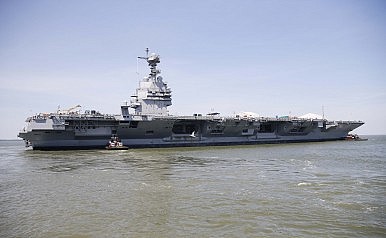Is the US Navy’s New Supercarrier Facing Additional Delays?
There is still no commissioning date for the lead ship of the U.S. Navy’s new class of aircraft carrier.
By Franz-Stefan Gady

The U.S. Navy has still not decided on a delivery date for the long-delayed nuclear-powered Gerald R. Ford-class aircraft carrier USS Gerald R. Ford (CVN-78), the commander of Naval Sea Systems Command (NAVSEA), Admiral Thomas J. Moore, told reporters on November 2 in Washington D.C., accordingto Seapower Magazine. NAVSEA will not decide on a commissioning date for the new warship until December.
The USS Ford was originally scheduled for a March delivery. Yet, the date had to be pushed back after a first round of tests revealed a number of shortcomings of the ship’s new and unproven system. Before setting a delivery date, the U.S. Navy has to determine the cause of problems with two main turbine generators (MTGs) on the new supercarrier. The admiral said that the MTGs have a manufacturing defect that will need to be addressed.
According to Moore, the U.S. Navy is “is just about done getting our way through with the root-cause analysis [on the fault with the MTG’s] and putting some fixes in place. I expect us to be testing the MTGs on Ford within the next couple of weeks. The issues you see on Ford are unique to those particular machines and are not systemic to the power plant or to the Navy as a whole.”
Enjoying this article? Click here to subscribe for full access. Just $5 a month.
The USS Ford also experienced problems with its so-called the Advanced Arresting Gear (AAG) on the flight deck. According to the admiral, the testing of the Electromagnetic Aircraft Launch System is complete and the testing of the Advanced Arresting Gear (AAG) is about 56 percent done. “We’re had the first 12 aircraft land into AAG,” he said. “We thought that would take a week. We did it in a day,” Moore added.
The ship’s Dual-Band Radar and the Advanced Weapons Elevators also require further testing. “The rest of the ship is essentially complete,” the admiral noted.
One of the major issues that has plagued the Ford carrier program from the outset is its huge price tag. According to the Congressional Research Service:
CVN-78 was procured in FY2008. The Navy’s proposed FY2017 budget estimates the ship’s procurement cost at $12,887.0 million (i.e., about $12.9 billion) in then-year dollars. The ship received advance procurement funding in FY2001-FY2007 and was fully funded in FY2008- FY2011 using congressionally authorized four-year incremental funding. To help cover cost growth on the ship, the ship received an additional $1,374.9 million in FY2014-FY2016 in FY2015 in so-called cost-to-complete procurement funding.
The cost overruns and unproven technology installed on the carrier have drawn the ire of a number of U.S. lawmakers including Senate Armed Services Committee chairman John McCain. An Independent Review Team is currently in the middle of examining all aspects of the Ford program. The team’s work is expected to be completed in December.
Next to the USS Ford, the construction of three additional supercarriers (CVN-79, CVN-80, and CVN-81) has been announced. (In total, the U.S. Navy plans for a fleet of ten Ford-class carriers.) The admiral said that construction of CVN-79 is 23 percent complete with many lessons from the USS Ford having been incorporated. “The shipbuilder remains on track with their target to reduce the construction man-hours by 18 percent relative to CVN 78,” he said.
Back to Top